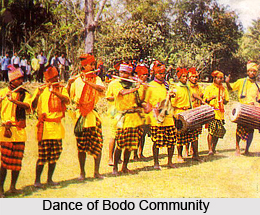 Bodos of Udalguri district comprises an ethnic local community who were the earliest settlers of the Eastern Indian state of Assam. The 1991 census had stated that Assam boasted of as many as 1.2 million Bodos, which constitute 5.3% of the aggregate population of this state. The Bodo people are part of a gigantic local ethnic group, which is referred to as the `Bodo-Kachari`. They mainly inhabit the town of Kokrajhar.
Bodos of Udalguri district comprises an ethnic local community who were the earliest settlers of the Eastern Indian state of Assam. The 1991 census had stated that Assam boasted of as many as 1.2 million Bodos, which constitute 5.3% of the aggregate population of this state. The Bodo people are part of a gigantic local ethnic group, which is referred to as the `Bodo-Kachari`. They mainly inhabit the town of Kokrajhar.
The Bodos are concentrated in numerable regions of North-Eastern India, as well as areas of the country of Nepal. They are a part of the famous 18 ethnic sub groups which belong to the Bodo-Kachari community. The other major ethnic groups existent in Udalguri district include Hojai who are based in the northern part of Cachar Hills, Dimasa who reside in the very same region, and Thengal and Sonowal who occupied the eastern portions of the Brahmaputra River. Some of the regional tribes of Udalguri district like Sarania, Koch and others have embraced the religion of Hinduism while others have their own identities like the Garo tribes.
Some of the common surnames utilized by the Bodo groups are Owary, Narzary, Basumatary, Khakhlary, Ishwary, Ramsiary, Mwshahary, Bodosa, Bwiswmuthiary, Goyary, Brahma, Boro, Dwimary, Sargwary, Ishlary, Borgayari, Wary and Sibigry. According to the 1971 census, Bodos represent the eighth largest ST or Scheduled Tribe in this country and about I million people communicate through the Bodo language. It is said that the Bodo language is obtained from The Tibeto-Burmese family of languages. However, recently, they prefer interacting in the Devanagari script. The Bodos possess their individual language script known as the `Deodhai`.
During ancient ages, Bodos are believed to have started cultivating rice, tea and tea. Other farming activities included silkworm rearing and poultry farming, particularly in the North-Eastern part of India. `Zu Mai` is the traditional drink of the Bodos and rice forms their staple diet. Weaving is an important local industry. Young Bodo girls are imparted training in the field of weaving and it is said that a Bodo home is incomplete if it is devoid of a loom. `Dokhnas` or traditional dresses of the Bodo people are woven expertly by the local Bodo women. Apart from weaving, Bodos are also excellent bamboo craftsmen.
In olden times, the Bodos were known to worship their ancestors but nowadays, religions like Hinduism, Bathousism and others are practiced. Kherai Puja is an essential ritual which is a part of Bathousism. This religion involves worshipping the forefathers of the Bodos. `Ba` implies five and `thou` means deep, as per the language of the Bodos. Another religion which is followed by many Bodos is that of Brahmaism. Fire burning is performed to worship the Bathou God. Several Bodos are also said to practice the Brahma Dharma.
The Bodoland Territorial Council has been granted to the people of Bodos of Udalguri district. Historical records have asserted that the Bodos have struggled for their independence in the 1980`s under the leadership of Upendra Nath Brahma, who is now revered as the father of the Bodos or `Bodo-Fa`. After a prolonged struggle, the Bodos attained Kokrajhar and other adjacent regions under their jurisdiction. Bodo Liberation Tigers (BLT) and All Bodo Students Union (ABSU) spearheaded the movement for autonomy of the Bodos.
Bodos are mostly farmers. Betel nut plantations, fishery, jute cultivation, rice plantation and others are significant agricultural industries of the Bodos of Udalguri district. Corns and mustard are other important crops planted by them. The religions of Christianity, Brahma Dharma, Islam and Assamese Sarania are said to have inspired the social culture of the Bodo community.



















